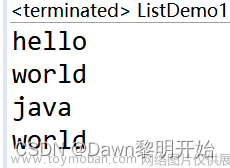-
Add:向集合中添加元素。
List<int> numbers = new List<int>(){ 1, 2, 3 }; numbers.Add(4); // numbers 现在为 { 1, 2, 3, 4 } -
Remove:从集合中移除指定的元素。
List<int> numbers = new List<int>(){ 1, 2, 3, 4 }; numbers.Remove(3); // numbers 现在为 { 1, 2, 4 } -
Contains:检查集合中是否包含指定的元素。
List<int> numbers = new List<int>(){ 1, 2, 3, 4 }; bool containsThree = numbers.Contains(3); // containsThree 为 true -
Clear:从集合中移除所有元素。
List<int> numbers = new List<int>(){ 1, 2, 3, 4 }; numbers.Clear(); // numbers 现在为空集合 {} -
Count:获取集合中元素的数量。
List<int> numbers = new List<int>(){ 1, 2, 3, 4 }; int count = numbers.Count; // count 现在为 4 -
Sort:对集合进行排序。
List<int> numbers = new List<int>(){ 3, 2, 4, 1 }; numbers.Sort(); // numbers 现在为 { 1, 2, 3, 4 } -
Reverse:反转集合中元素的顺序。
List<int> numbers = new List<int>(){ 1, 2, 3, 4 }; numbers.Reverse(); // numbers 现在为 { 4, 3, 2, 1 } -
Find:查找符合指定条件的第一个元素。
List<int> numbers = new List<int>(){ 1, 2, 3, 4 }; int evenNumber = numbers.Find(x => x % 2 == 0); // evenNumber 现在为 2 -
FindAll:查找符合指定条件的所有元素。
List<int> numbers = new List<int>(){ 1, 2, 3, 4 }; List<int> evenNumbers = numbers.FindAll(x => x % 2 == 0); // evenNumbers 现在为 { 2, 4 } -
FindIndex:查找符合指定条件的第一个元素的索引。
List<int> numbers = new List<int>(){ 1, 2, 3, 4 }; int index = numbers.FindIndex(x => x % 2 == 0); // index 现在为 1(等于2的索引) -
FindLast:查找符合指定条件的最后一个元素。
List<int> numbers = new List<int>(){ 1, 2, 3, 4, 2 }; int lastNumber = numbers.FindLast(x => x == 2); // lastNumber 现在为 2 -
FindLastIndex:查找符合指定条件的最后一个元素的索引。
List<int> numbers = new List<int>(){ 1, 2, 3, 4, 2 }; int lastIndex = numbers.FindLastIndex(x => x == 2); // lastIndex 现在为 4(等于2的最后一个索引) -
TrueForAll:判断集合中的所有元素是否都满足指定条件。
List<int> numbers = new List<int>(){ 1, 2, 3, 4 }; bool allEven = numbers.TrueForAll(x => x % 2 == 0); // allEven 为 false -
Exists:判断集合中是否存在满足指定条件的元素。
List<int> numbers = new List<int>(){ 1, 2, 3, 4 }; bool evenExists = numbers.Exists(x => x % 2 == 0); // evenExists 为 true -
Distinct:从集合中排除重复的元素。
List<int> numbers = new List<int>(){ 1, 2, 2, 3, 3, 4 }; List<int> distinctNumbers = numbers.Distinct().ToList(); // distinctNumbers 现在为 { 1, 2, 3, 4 } -
Union:合并两个集合,生成一个包含两个集合中唯一元素的新集合。
List<int> numbers1 = new List<int>(){ 1, 2, 3 }; List<int> numbers2 = new List<int>(){ 3, 4, 5 }; List<int> uniqueNumbers = numbers1.Union(numbers2).ToList(); // uniqueNumbers 现在为 { 1, 2, 3, 4, 5 } -
Intersect:获取两个集合中共有的元素。
List<int> numbers1 = new List<int>(){ 1, 2, 3 }; List<int> numbers2 = new List<int>(){ 3, 4, 5 }; List<int> commonNumbers = numbers1.Intersect(numbers2).ToList(); // commonNumbers 现在为 { 3 } -
Except:从第一个集合中移除在第二个集合中存在的元素。
List<int> numbers1 = new List<int>(){ 1, 2, 3, 4 }; List<int> numbers2 = new List<int>(){ 3, 4, 5 }; List<int> remainingNumbers = numbers1.Except(numbers2).ToList(); // remainingNumbers 现在为 { 1, 2 } -
Concat:将两个集合连接为一个新的集合。
List<int> numbers1 = new List<int>(){ 1, 2, 3 }; List<int> numbers2 = new List<int>(){ 4, 5 }; List<int> combinedNumbers = numbers1.Concat(numbers2).ToList(); // combinedNumbers 现在为 { 1, 2, 3, 4, 5 } -
Aggregate:使用指定的函数将集合中的元素聚合为一个值。
List<int> numbers = new List<int>(){ 1, 2, 3, 4 }; int sum = numbers.Aggregate((x, y) => x + y); // sum 现在为 10 -
Any:判断集合中是否存在满足指定条件的元素。
List<int> numbers = new List<int>(){ 1, 2, 3, 4 }; bool anyEven = numbers.Any(x => x % 2 == 0); // anyEven 为 true -
All:判断集合中的所有元素是否都满足指定条件。
List<int> numbers = new List<int>(){ 1, 2, 3, 4 }; bool allEven = numbers.All(x => x % 2 == 0); // allEven 为 false -
Min:获取集合中的最小值。
List<int> numbers = new List<int>(){ 1, 2, 3, 4 }; int min = numbers.Min(); // min 现在为 1 -
Max:获取集合中的最大值。
List<int> numbers = new List<int>(){ 1, 2, 3, 4 }; int max = numbers.Max(); // max 现在为 4 -
Average:计算集合中元素的平均值。
List<int> numbers = new List<int>(){ 1, 2, 3, 4 }; double average = numbers.Average(); // average 现在为 2.5 -
Sum:计算集合中元素的总和。文章来源:https://www.toymoban.com/news/detail-670937.html
List<int> numbers = new List<int>(){ 1, 2, 3, 4 }; int sum = numbers.Sum(); // sum 现在为 10
请注意,示例中使用的集合类型为List<int>,其他数据类型和集合类型也可以按照类似的方式使用这些操作方法。文章来源地址https://www.toymoban.com/news/detail-670937.html
到了这里,关于C# 中操作集合的方法的文章就介绍完了。如果您还想了解更多内容,请在右上角搜索TOY模板网以前的文章或继续浏览下面的相关文章,希望大家以后多多支持TOY模板网!






